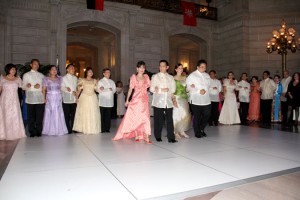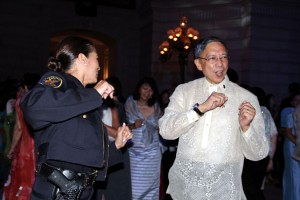
Former Mayor Willie Brown with Ralph Colet and wife, Carmen, chairperson of San Francisco-Manila Sister City Committee
SAN FRANCISCO—They came in their finest finery, the ladies in graceful, floor-length, brightly colored butterfly-wing ternos, the gentlemen in black-tie tuxedos or exquisitely hand-embroidered Barong Tagalogs. The rotunda of the beaux-arts building that is the San Francisco City Hall was just as elegantly dressed, bathed in the soft glow of subdued lighting and bedecked in flowers and flags, the grand staircase rising ever majestically as if awaiting royalty. A violin was playing, the melody echoing in the cavernous domed rotunda that has hosted and witnessed historic events since it was built more than 100 years ago.
In a certain sense, it was an historic event unfolding that evening. This was the gala celebration of the 114th anniversary of the Declaration of Philippine Independence, of the birth of democracy in those tropical islands speckled on the South China Sea. It was only the second such gala celebration by a Bay Area Filipino-American community that is slowly emerging into political and social significance after decades of being a quiet though significant economic contributor; a celebration that had, until last year, been relegated to casual, open-air affairs at Union Square or the Yerba Buena Gardens or some other major city park.
Guests lingered at the entrance lobby, awaiting formal announcement to and welcome from Consul General and Mrs. Marciano Paynor, before entering the rotunda where they were treated to a hosted full bar serving cocktails mixed mostly from Philippine vodka, rum, or liqueur and Philippine fruit juices.
The formal start of the evening was signaled by the presentation of colors and by the singing of the Philippine and the US national anthems by Filipino musical artists Marcia Lopez and Joel Baluyot respectively.
Consul General Paynor then delivered the keynote speech, citing the theme of this year’s Bay Area celebration, “A New Generation of Heroes: Connect, Inspire, Empower”, which recognizes “the role of younger generations of Filipinos and Filipino-Americans in preserving the gains of our forefathers’ legacy”. True to the theme, this year’s gala saw a remarkable increase in attendance from the youth sector compared to last year.
State Senator Leland Yee also spoke, singling out Filipino-American professionals in the health care and medical fields.
But the most applauded speaker of the evening was special guest speaker Jessica Cox. Ms. Cox was born without arms yet has excelled in fields that would challenge the more physically able. Calling herself “differently-abled”, she expounded on her belief that the way people think has a greater impact on their lives than physical limitations. With this philosophy, she went into martial arts and became the first armless person to earn a black belt in Tae Kwon-do. She also graduated with a college degree in Psychology from The university of Arizona. But her most celebrated accomplishment is learning to fly a plane. Ms. Cox has received recognition from Guinness World Records for being the first person certified to fly a plane with only her feet. She is now a highly sought-after motivational speaker.
Then, it was time for the Rigodon de Honor, the country’s ceremonial dance that has been part and parcel of every Filipino gala event for generations. Traditionally performed by selected members of the higher echelons of government and of Philippine society, this year’s Rigodon was led by no less than Consul General and Mrs. Paynor. Other dancers included Ralph and Carmen Colet, JR Calanoc and Marivic Agoncillo, Denny Roa and Sol Manaay, Irwin Ver and Gemma Nemenzo, Christopher Barra and Wendy Andong, Eric Capalla and Dell Merano, Bradley Roxas and Allen Capalla, Francis Espiritu and Lourdes Tancinco, Jaime Ramon Ascalon and Teresita Paynor, Marciano Paynor, Jr. and Joanne del Rosario, and Rene Malimban and Sonia Delen. The choreography was done by Johnny Veloso.
After the Rigodon the guests were ushered into the dining room for the formal, sit-down dinner that started with a salad of baby beets and mango served with Laura Chenel goat cheese, wild arugula, shaved almonds, and tropical fruit vinaigrette. The entrée was boneless beef short rib braised in dry red wine and served in reduced braising jus with celery root potato puree and caramelized rainbow carrots and accompanied by Jade Mountain 2004 Napa County merlot. For dessert, it was chocolate pot au crème with fresh raspberries Florentine.
The musical entertainment, a preview of which the guests had had earlier in the evening, kicked off with an Ifugao dance performed by the Parangal Dance Company. Filipino opera singer Joel Baluyot followed with Circle of Life and soprano Marcia Lopez with I Dream A Dream. The Angelos, three young Filipino tenors, brought the house down with Somewhere and This is The Moment. Then, the evening’s heart-touching patriotic moment, with Miriam Pantig, Joel Baluyot and Marcia Lopez blending their voices in singing the country’s unofficial anthem, Ang Bayan Ko while members of the Parangal Dance Company stood on and around the stage waving giant Philippine flags, bringing the crowd to its feet.
Miss Pantig segued into the Philippine disco hit song, Sumayaw, Sumunod, which drew the audience to the rather limited space in front of the stage to dance. A few more dance numbers from Ms. Pantig and the dinner and musical performances portion of the event wound down but only to continue outside in the rotunda where the dancing continued on till late into the night.
It was a celebration worthy of a people that had largely toiled in silence, keeping a low political profile and focused on fashioning the better life for which they had left their motherland 8,000 miles behind. It has been only these last few years that have signaled the Filipino’s true arrival in this country. It was, in some sense, the “royalty” of the Bay Area’s Filipino community that had gathered there that night—community advocates and corporate executives, students and teachers and policemen and postal workers, political personages and government leaders, engineers and homemakers, successful businessmen and respected journalists, lawyers and doctors and medical practitioners, artists and performers and patrons of the arts–the quiet achievers who form the ranks of this progressive, upwardly mobile Asian minority. It was a celebration they, and all Filipino-Americans everywhere in this their new home, deserved



